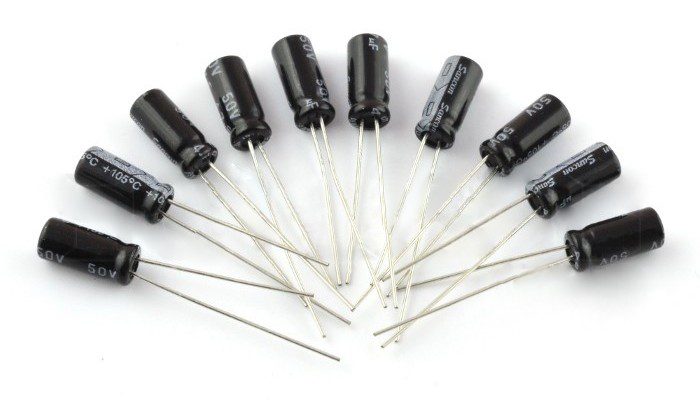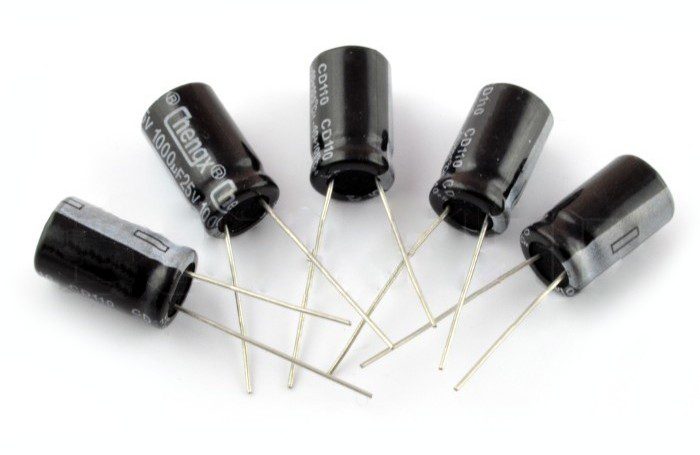Table of Contents:
- 1 Electrolytic capacitor - basic information
- 2 Capacitance of electrolytic capacitors - the most important parameter
- 3 Other parameters of the electrical capacitor
- 4 Types and design of electrolytic capacitors
- 5 Charging and discharging electrolytic capacitors
- 6 Electrolytic capacitors in THT and SMT housings
Electrolytic capacitors are electronic components that have the ability to store energy. They are equipped with two conductors separated by a dielectric. What else is worth knowing about them?
Electrolytic capacitor - basic information
Electrolytic capacitors are components commonly used among others. In electronics. They are capable of storing a certain amount of electricity. This capacity is referred to as the capacitance of the capacitor, a key technical parameter that determines its use.
The electrolytic capacitor is distinguished by its wide application in passive and active electronic circuits. They are used to filter signals, stabilize power flow and voltage in circuits. In addition, they are used to block the flow of direct current while allowing alternating current to flow freely.
You can find two types of electrolytic capacitors on the market. The first are aluminum models distinguished by their relatively low price and standard electrical performance. The second group includes tantalum electrolytic capacitors, which are more expensive than aluminum models, but offer better electrical performance.
Capacitance of electrolytic capacitors - the most important parameter
The key parameter of electrolytic capacitors is the mentioned capacitance expressed in farads. With this information, we know how much energy a particular capacitor model can safely store. This parameter is always individually selected for a specific application. One farad is a very large unit, so aliquots of it are used to describe the capacitance of electrolytic capacitors used in electronics. These are fractional parts of one farad. The most commonly used aliquots include microfarads, denoted as 1μF (10-6F), nanofarads, or nF (10-9F), and picofarads, or pF (10-12F).
Other parameters of the electrical capacitor
The next important technical parameter of the capacitor is the maximum operating voltage. It determines how high an operating voltage a capacitor can “withstand” without risking damage. What affects the maximum voltage level of this component? The most important factors are dielectric thickness and properties. Exceeding the maximum operating voltage of the capacitor can cause a puncture, which is capable of causing total damage. In extreme cases, a short-circuit of the two covers can cause the capacitor to “swell” or even explode.
When adjusting a particular model of electrical capacitor, and more specifically, the parameter that determines the maximum voltage rating, it is necessary to take into account the operating voltage of the system, overvoltage and instantaneous voltage rise.
Types and design of electrolytic capacitors
The different types of capacitors differ not only in their electrical parameters (capacitance and maximum operating voltage), but also in the material of the dielectric. The part of the capacitor responsible for the separation of the covers can be made, for example, of ceramics, paper or various types of polymers. Other differences include the structure of the covers and the type of housing.
The capacitance of electrolytic capacitors available on the market mostly ranges from a few picofarads to a few kilofarads. The maximum capacitance of supercapacitors is about 5 kF.
The use of capacitors with a capacitance of more than 1 microfarad includes almost exclusively electrolytic models. Their popularity is due to a combination of compact size and relatively low price.
Charging and discharging electrolytic capacitors
Theoretically, once charged capacitor should retain its capacitance for an arbitrarily long time (when not connected to a load). However, in practice, capacitors are susceptible to the so-called self-discharge effect. What is the reason for this? First of all, from the properties of the dielectric material. As time passes, electricity flows through it. Although these values are negligible, they lead to partial or complete self-discharge of the capacitor within a certain unit of time. The length and intensity of this phenomenon depend on, among other things. On the construction of the capacitor and the type of dielectric.
When this electronic component is loaded, there is a current flow that causes the voltage between the covers to drop. When the voltage level drops to 0 V, then we are talking about a situation in which the capacitor is completely discharged.
A good example is connecting an electronic capacitor to a load in the form of a resistor. The voltage drop of the capacitor will depend on the magnitude of the discharge current. The time required to fully discharge electrolytic capacitors with higher capacitance is longer than for models with lower capacitance (for the same load).
Electrolytic capacitors in THT and SMT housings
Electrolytic capacitors come in two housing variants. The first is THT ( Through-Hole Technology), also known as through-hole assembly. Capacitors of this type are equipped with two leads in the form of wire feet inserted into the holes of the PCB. During THT assembly, the electrical capacitor lead is translated (through the aforementioned holes) to the other side of the board and soldered to the solder fields. These locations are connected to the conductive paths of the board.
In contrast, electrolytic capacitors in SMD ( Surface Mounted Devices) housings are designed for SMT (Surface Mount Technology) mounting. This technology is used in, among other things. serial production. Compared to THT assembly, it is much faster, so it has displaced through-hole assembly in professional applications. The threaded technique is currently being used by hobbyists and DIY enthusiasts. Because of its easy learning curve, THT assembly is a common choice for electronics beginners. In addition, THT assembly is used during prototyping and testing of new circuits consisting of a relatively small number of electronic components.
How useful was this post?
Click on a star to rate it!
Average rating 0 / 5. Vote count: 0
No votes so far! Be the first to rate this post.





















